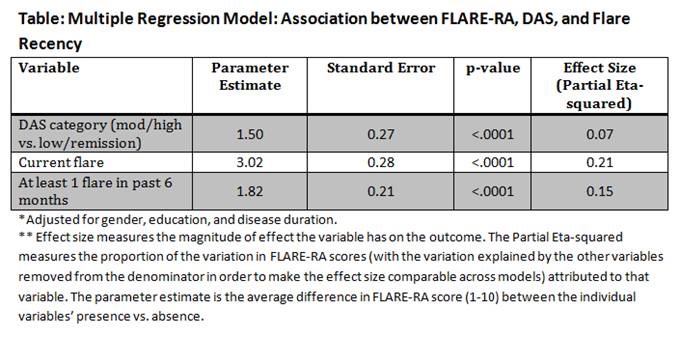Session Information
Date: Sunday, November 5, 2017
Title: Rheumatoid Arthritis – Clinical Aspects Poster I: Treatment Patterns and Response
Session Type: ACR Poster Session A
Session Time: 9:00AM-11:00AM
Background/Purpose: Clinicians often associate the occurrence of a recent rheumatoid arthritis (RA) flare with an increase in overall disease activity. However, previous studies have shown that patients with RA in low disease states still report flares. The goal of this study is to examine if having a recent flare is independent from disease activity overall, using the FLARE-RA instrument.
Methods: Data were collected from a prospective RA registry including patient reported and clinical outcomes, such as flare frequency and the FLARE-RA instrument. FLARE-RA asks patients to rate 11 statements about their disease on a 0-10 scale (not true to absolutely true). The statements are about patient and physician identified flare features covering the following: morning stiffness, joint pain, joint swelling, sleep disturbance, pain killer or NSAID use, fatigue, decrease in physical activity, irritability, depression, withdrawal, and increased need for help. The score is the mean of all 11 items, where a higher score suggests a recent flare. Disease Activity Score 28 joint with CRP (DAS) was dichotomized into low/remission and moderate/high disease. Flare recency (presence of a flare in the past 6 months) was coded into 3 categories; no flare, at least 1 flare, and currently flaring. Nonparametric tests were performed to examine possible covariates in relation to the FLARE-RA score. A multiple regression model with FLARE-RA score as the outcome included covariates that had a p<0.15 in the univariate analyses.
Results: 503 participants were surveyed; 85% were female with a mean (SD) age of 61 (13), 75% had a college degree or higher, and the median disease duration was 16 (IQR 9, 26) years. The median DAS28-CRP3 was 2.1 (1.6, 2.8) and the median FLARE-RA score was 2 (0.5, 4.4). In univariate analyses, a linear trend between DAS category, flare recency, and FLARE-RA was seen (Figure). The regression model found that having a recent flare is associated with a higher FLARE-RA score independent of DAS category, while adjusting for gender, education, and disease duration. Additionally, flare recency had a higher effect size than DAS on total FLARE-RA score.
Conclusion: Having a current or recent flare drives the FLARE-RA score more than a patient’s current disease activity suggesting that this instrument is able to detect patients’ self report of flare. This instrument may be useful in detecting flares even in patients with low disease activity which could provide an additional rationale for treatment change.
To cite this abstract in AMA style:
Mahmoud TG, Frits M, Iannaccone C, Maica G, Bykerk VP, Weinblatt M, Shadick NA. FLARE-RA Instrument Detects RA Flares Independent of Disease Activity [abstract]. Arthritis Rheumatol. 2017; 69 (suppl 10). https://acrabstracts.org/abstract/flare-ra-instrument-detects-ra-flares-independent-of-disease-activity/. Accessed .« Back to 2017 ACR/ARHP Annual Meeting
ACR Meeting Abstracts - https://acrabstracts.org/abstract/flare-ra-instrument-detects-ra-flares-independent-of-disease-activity/


